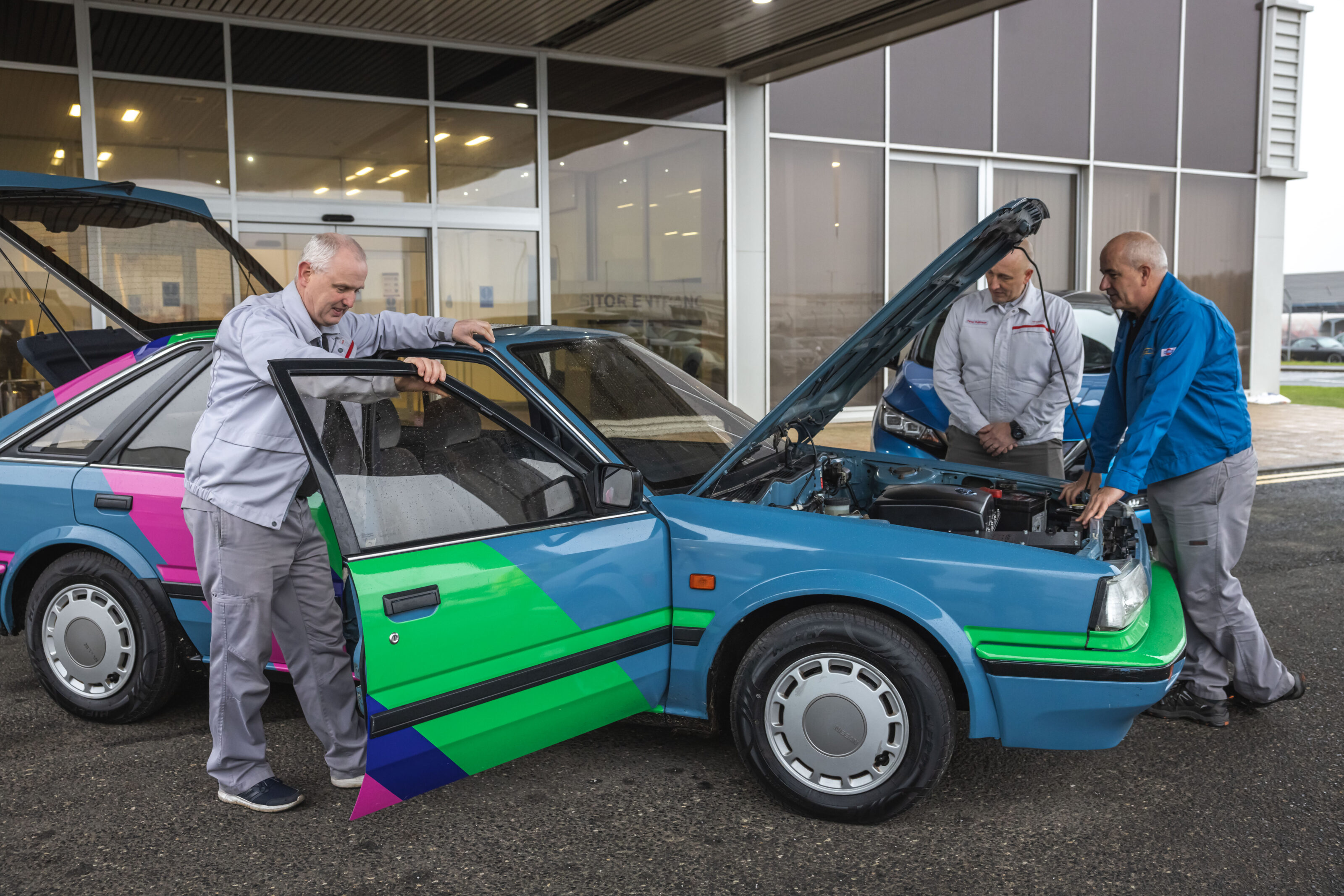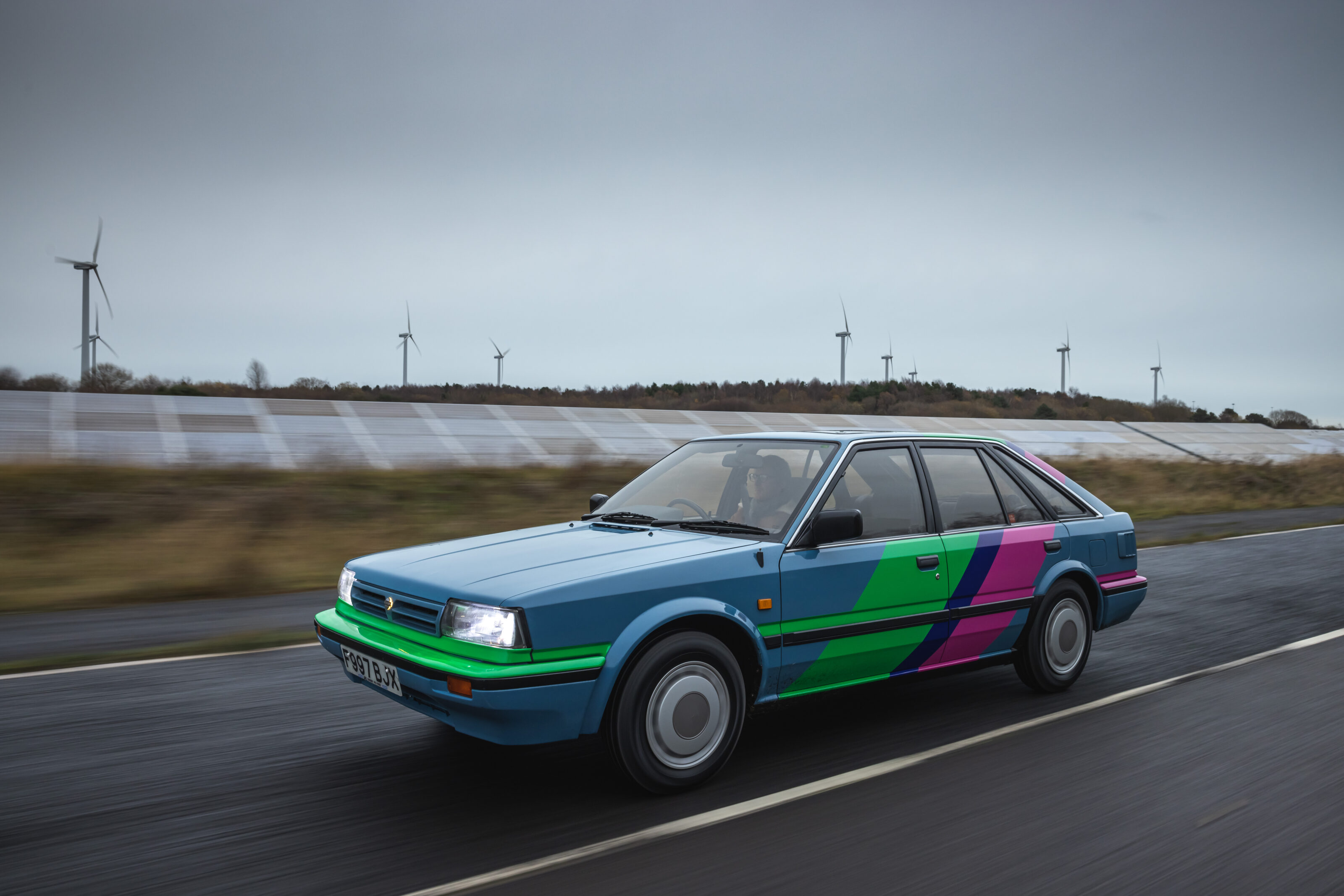Things we like
- A thoroughly natural EV restomod
- And a truly fastidious build, too
- Nippier and sharper to drive than you’d dare think
Not so much
- It’s not for sale
- Decals don’t make a Bluebird sexy
- Erm, no CarPlay? ?♂️
It’s a jolly good job the decals are there, really. Or else it’d be very easy to divert your eyes from one of the most wantonly boxy shapes in automotive history. As someone born at the tail end of the Eighties, it’s difficult for me to fathom exactly how a Nissan Bluebird looked on European roads when it was brand spanking new. Given it’ll have shared tarmac with the jelly-mould Ford Sierra, I can only assume its set-square lines appeared desperately plain.
But some neon graphics lift things notably, even if they’re plastered across this 1988 car’s original shade of blue. And technically this is no longer a Bluebird, at least if we’re to take the marketing at face value. This is the Nissan Newbird, and it’s that most fashionable of things right now – an electrically powered restomod.

‘Why?’ is a fair and valid question to ask. And the answer is somewhat sweet. Nissan opened up its Sunderland plant on the north-east coast of England in 1986, and the Newbird was conceived to celebrate the 35th anniversary. It thus unites the T12-generation Bluebird – the first car ever cranked out by a mixture of robots and hard-worked Mackem hands more used to mining coal or building ships – and the electric-powered Leaf, one of the factory’s more recent product lines.
Those familiar with the feisty bottom half of the internet, where opinions are binary and rarely measured, will know that scooping out the internally combusted innards of an old car and replacing them with a motor and batteries is a divisive move. We’re not looking at an old E-Type Jag or Porsche 911 here, though. And as a result, I think we’re looking at the most successful EV conversion yet.
‘Why?’ is a valid question to ask. And the answer is somewhat sweet. Nissan opened its Sunderland plant in 1986, and the Newbird was conceived to celebrate its 35th anniversary

The formula really is as simple as 1980s hatchback meets 2020s power source, though to keep things as sustainable as possible, the motor and inverter come from a crash-damaged Mk1 Leaf, while the batteries are those you’ll find plonked in a brand-new Mk2, to broaden its range figure to a 200km maximum.
To ensure Britain’s most productive car plant didn’t have its profit margins sliced by a bespoke one-off, the work was trusted to a specialist in the divisive field of plug-in heart transplants. Namely Kinghorn Electric Vehicles, based a few miles down the road in the picturesque cathedral city of Durham.

Project chief George Kinghorn is a proud perfectionist. The whole thing took around eight weeks, and a niggling job that lasted far too many of those was hooking the battery modules up to the fuel gauge, so that the old needle would display the state of its new-age power source.
Sticking something digital among the dash would have been easier, but it wouldn’t have been right, says George. He’s also keen to switch the ‘R N D’ selection dial for a period Bluebird automatic shifter at the first chance Nissan lets him. While the battery modules currently fill both the boot and engine bay, they’d slot into the floor if Kinghorn had the heart (or permission) to start slicing an old shell. Those resto-EV sceptics could do with sitting down for a cup of tea with George. He might just win them round.

As might his car. Sticking a load of heavy batteries in an already proudly undynamic repmobile is a predictably unrevolutionary move. Especially when George has dialled in an appropriate powerband.
“We wanted a smooth, relaxed urban car,” he says. “It’s all in the tuning. We can turn it up to 200bhp and double the power but we always go in softly and Nissan liked this, more wafty approach. Plug the laptop in and we can make it go bananas, though.”
The formula really is as simple as 1980s hatchback meets 2020s power source, the motor coming from a Mk1 Leaf while the batteries are those of a Mk2, broadening its range to 200km

Things are resolutely un-bananas as it stands. The Mk1 Leaf’s original 67kW output has swelled to 80kW, while torque climbs from 143 to 289Nm. With the Newbird’s weight figure impressively close to a stock 1.8-litre petrol-powered Bluebird – up just 35 kilos at 1190kg – you’d expect a reasonable boost to performance. But it’s actually slower, George and his team respecting the stern work they’d be asking of 34-year-old components by developing an oh-so-gentle torque curve that produces a beyond-modest 15-second 0-100km/h time.
As those benchmark stats rarely do, however, it simply doesn’t tell the story of how the Newbird reacts to a vigorous throttle input. From a standstill, it’s undeniably lethargic but from 50-80km/h, for instance, it zips along delightfully. And all without a sliver of the wheelspin instant torque can sometimes provoke. In fact, for all George’s claims that this is an urban car, it feels hemmed-in at residential speed limits.

Accelerate out of one and you’d swear there’s a lot more power driving the front axle than Kinghorn claims. It feels most natural settled at a multi-lane cruise, far from the slowest car on the road, much like the position it would have occupied transporting the travelling salesman of the Eighties around in its former life. Only now, on the streets of the city it celebrates, it attracts the attention of an A-lister.
It kinda handles, too. Ask for too much throttle in the middle of a corner, before you’ve fully straightened the wheel, and it’ll understeer for England and Japan. But treat it with a bit more respect and its low kerb weight lends it decent agility, while the steering is light and breezy and the brakes possess a neat amount of regen, roughly in line with the sort of engine braking a manual Bluebird might have had. With new Bilstein damping to help cushion its odd weight distribution, it’s a surprisingly natural thing to drive once you’ve got past the electric whoosh so unexpected in a car with a Blaupunkt tape deck. And it’s all so tuneable, too, with the regen level and power output at the whim of the buyer walking into Kinghorn’s charming little workshop.

Which brings us to money, something of a moot point given this is a promotional one-off. If you begged desperately and funnelled around $75,000 in Nissan’s direction, you might have a mite of a chance. But you’d be better routing the same chunk of cash at Kinghorn to create a bespoke Leaf-powered classic of your own choosing. It’s the company’s speciality and their phone’s been off the hook since the Newbird first graced the press. Now that everyone knows how fastidiously it’s been converted, I can only imagine the waiting list will grow.
2021 Nissan Newbird specifications
| Body | Five-door hatchback |
|---|---|
| Drive | Front wheel drive |
| Engine | 80kW electric motor, 40kWh battery, 6.6kW charger |
| Power | 80kW |
| Torque | 280Nm |
| 0-100km/h | 15sec (est) |
| L/W/H | 4369/1701/1397mm |
| Weight | 1190kg |
| Front suspension | Independent MacPherson strut, coil springs, adjustable Bilstein dampers |
| Rear suspension | Independent semi-trailing arm, coil springs, adjustable Bilstein dampers |
| Price | N/A, but $75,000-plus if you want your own version |
Things we like
- A thoroughly natural EV restomod
- And a truly fastidious build, too
- Nippier and sharper to drive than you’d dare think
Not so much
- It’s not for sale
- Decals don’t make a Bluebird sexy
- Erm, no CarPlay? ?♂️







